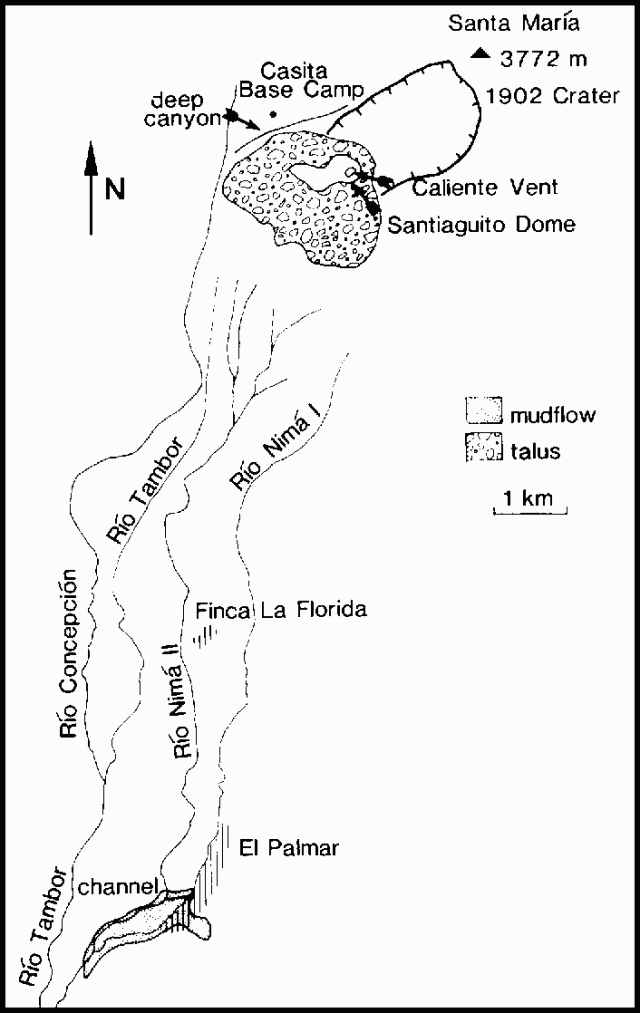Report on Santa Maria (Guatemala) — November 1983
Scientific Event Alert Network Bulletin, vol. 8, no. 11 (November 1983)
Managing Editor: Lindsay McClelland.
Santa Maria (Guatemala) Small ash ejections; mudflow damages town
Please cite this report as:
Global Volcanism Program, 1983. Report on Santa Maria (Guatemala) (McClelland, L., ed.). Scientific Event Alert Network Bulletin, 8:11. Smithsonian Institution. https://doi.org/10.5479/si.GVP.SEAN198311-342030
Santa Maria
Guatemala
14.757°N, 91.552°W; summit elev. 3745 m
All times are local (unless otherwise noted)
"A group from Michigan Tech. and INSIVUMEH visited Santiaguito 15-16 November to observe its activity and recent mudflow damage. Activity was very similar to that of February 1982 with small vertical ash eruptions occurring at 30-minute intervals. Typical eruption cloud heights were 200-300 m above Caliente Vent, which has built an ash cone around it to an elevation equal to the highest spines of the dome (2,500 m). Occasionally in the last few months much larger explosions, to elevations of at least 1 km above the vent, have been observed by residents of the coastal slope. Extrusion of lava continues from the area near Caliente Vent, producing incandescent rockfalls into the Río Nimá II and other nearby rivers (figure 2).
"The combined effects of continued lava extrusion and avalanching, the incessant ash emissions, and an unusually wet rainy season have increased the hazard of mudflows in the Río Nimá II, Río Tambor, and Río Concepción south of Santiaguito. Around and just below the dome at 1,700-2,000 m, deep canyons have been incised into the volcanic debris. On the N side of the dome, the 1902 crater has been breached and a deep canyon separates the dome from the Casita Base Camp. The formerly stabilized talus slopes of the dome have become active again because of the erosion from below. Beginning in late June and continuing into August, the Río Nimá II was especially active, aggrading several tens of meters at Finca La Florida (900 m altitude) and downstream at the town of El Palmar (680 m altitude). The situation at El Palmar was complicated by the confluence of Ríos Nimá I and II. The debris in the Nimá II eventually dammed the Nimá I, creating a natural reservoir which was becoming larger quickly. More and more mudflow and fluvial debris choked the previous mouth of the Nimá I. A channel was dredged through the debris but before it could be sufficiently deepened the Nimá I broke out of its reservoir and suddenly overflowed into the southern part of El Palmar. Evacuation of several hundred people prevented loss of life there, but several dozen houses were completely destroyed by mudflows created by the reservoir waters and the volcanic debris. As the rains lessened, the rivers seemed to be downcutting into the new laharic material and the danger of mudflows seemed less."
Further Reference. Rose, W.I., 1987, Volcanic activity at Santiaguito Volcano, 1976-1984: Geological Society of America Special Paper 2121, p. 17-27.
Geological Summary. Symmetrical, forest-covered Santa María volcano is part of a chain of large stratovolcanoes that rise above the Pacific coastal plain of Guatemala. The sharp-topped, conical profile is cut on the SW flank by a 1.5-km-wide crater. The oval-shaped crater extends from just below the summit to the lower flank, and was formed during a catastrophic eruption in 1902. The renowned Plinian eruption of 1902 that devastated much of SW Guatemala followed a long repose period after construction of the large basaltic andesite stratovolcano. The massive dacitic Santiaguito lava-dome complex has been growing at the base of the 1902 crater since 1922. Compound dome growth at Santiaguito has occurred episodically from four vents, with activity progressing E towards the most recent, Caliente. Dome growth has been accompanied by almost continuous minor explosions, with periodic lava extrusion, larger explosions, pyroclastic flows, and lahars.
Information Contacts: W. Rose, Jr., S. Halsor, and T. Bornhorst, Michigan Tech. Univ.; E. Quevec Robles and C. Martínez, The Instituto Nacional de Sismología Vulcanología, Meteorología, e Hidrología (INSIVUMEH), Guatemala City.


